Portraits on Roman provincial coins range from crude to skillfully engraved
Roman provincial coins–those struck outside of Italy, in the provinces of Rome–are among the most fascinating of all ancient coins. They often have intriguing designs and bear portraits of great interest.
The die engraving on provincial coins varies incredibly, from cartoonish efforts to artistic masterpieces. In this column, we’ll illustrate a variety of the portrait styles a collector of Roman provincial coins is likely to encounter.
We’ll start with several examples with crude die engraving:

26 mm bronze of Calagurris in Spain
First is this 26 mm bronze of Calagurris in Spain, issued for Rome’s first emperor, Augustus (27 BCE-14 CE). Its portrait is especially simplistic.
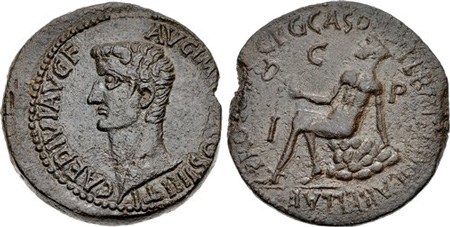
Sestertius-sized bronze of Emperor Tiberius
Perhaps struck at “Paterna” in Zeugitana (a region in North Africa), this sestertius-sized bronze has a rudimentary portrait of the emperor Tiberius (14-37 CE).
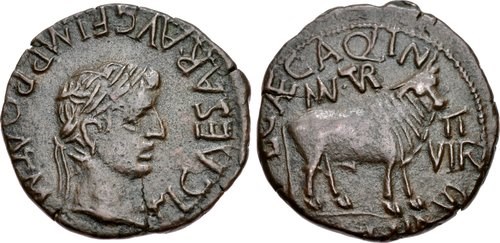
Bronze of Turiaso with portrait of Tiberius
Also bearing a crude portrait of Tiberius is this bronze of Turiaso in nearby Spain.

24 mm bronze of Edessa in Mesopotamia, struck for Severus Alexander
Similarly crude is this 24 mm bronze of Edessa in Mesopotamia, struck for Severus Alexander (222-235). The composition of the portrait is interesting, even if the style of engraving is poor.
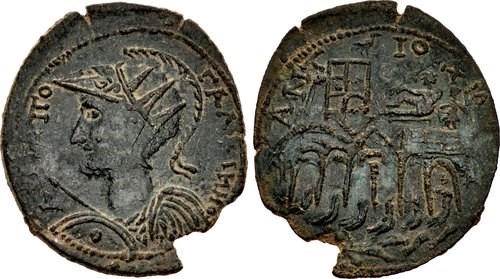
Bronze from Antiochia ad Maeandrum in Caria with portrait of Emperor Gallienus
This large provincial bronze from Antiochia ad Maeandrum in Caria bears a crude, military portrait of the emperor Gallienus (253-268 CE).
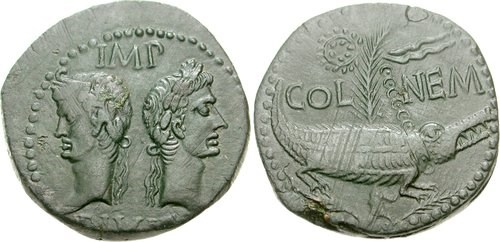
Bronze as of Nemausus with portraits of Augustus and Marcus Agrippa
This bronze as of Nemausus in Gaul misses the high mark of artistry often achieved at imperial mints in the empire, yet it’s nowhere near as crude as the five examples above. The obverse bears the portraits of Augustus and his general Marcus Agrippa.
In some instances, it can be reasonably assumed that engravers cut dies for both imperial and provincial coins. Below are two coins issued in Spain during the reign of Augustus which illustrate the point: an imperial-mint denarius (top) and a bronze of the mint of Bilbilis (bottom).
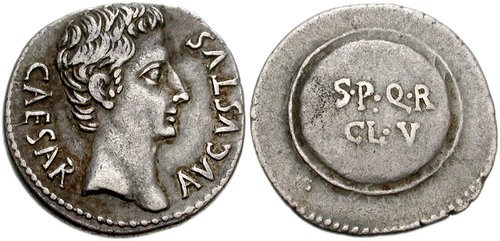

Nice Examples of Provincial Bronze
The standards of engraving were often quite good on silver coins issued by the Romans in their provinces. What follows are 15 especially nice examples.
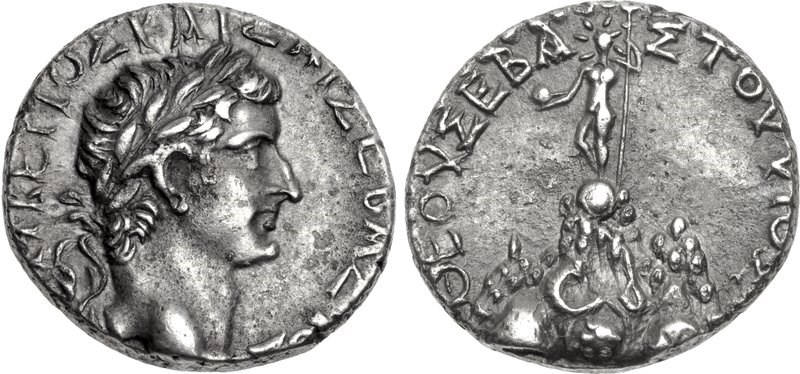
Drachm of Tiberius
This drachm of Tiberius was issued at the mint of Caesarea in Cappadocia. Its portrait is far better than most which appear on this emperor’s imperial-mint denarii.

Drachm bearing portraits of Germanicus and Augustus
Also from Caesarea is this drachm bearing the portraits of Tiberius’ nephew Germanicus (died 19 CE) and Tiberius’ predecessor, Augustus (now deified). Augustus’ portrait is especially well engraved.
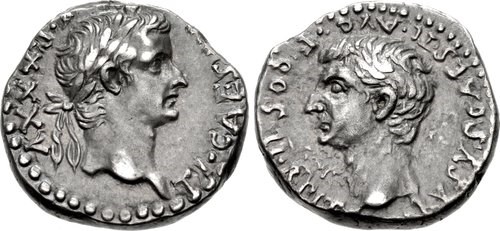
Drachm bearing the portrait of Tiberius and his son Drusus
This drachm from Caesarea bears the portrait of Tiberius and his natural son Drusus, who died of poisoning in 23 CE. It was struck for the 10th anniversary of the young heir’s death.

Cistophorus with portrait of Augustus
Among the largest Roman silver coins were cistophori, which were issued at provincial mints in Asia Minor that sometimes also struck Imperial coins. Their portraits often are magnificent, as with the piece, above, depicting Augustus.
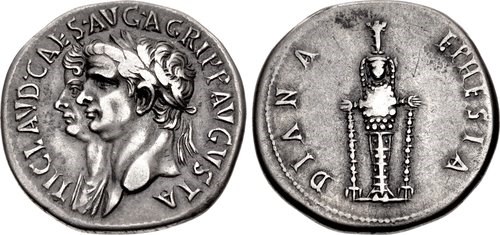
Cistophorus with busts of the emperor Claudius and his wife Agrippina Junior
Of equally refined style is this cistophorus with the jugate busts of the emperor Claudius (41-54) and his wife (and niece) Agrippina Junior.
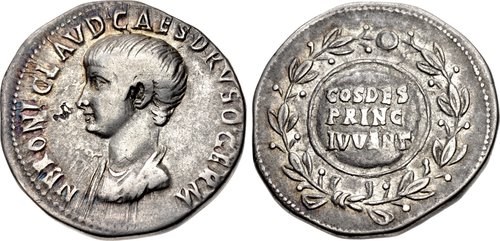
Cistophorus issued by Claudius with portrait of young Nero
Agrippina Junior’s son, Nero, was adopted by Claudius. A fine-style portrait of young Nero appears on this cistophorus, issued by Claudius in 50-54, while the young heir held the rank of Caesar. He succeeded Claudius as emperor in 54, and ruled until 68.

Cistophorus with portrait of Hadrian
The coin portraits of Hadrian (117-138) often are well-engraved, as on this cistophorus issued for him at Nicomedia, the capitol of Bithynia.

Tetradrachm of Vespasian
Another large-denomination Roman silver coin was the tetradrachm, which was issued at numerous mints throughout the eastern regions of the empire. The piece above was struck at Antioch in Syria for Vespasian (69 to 79). In this case his portrait is of the very finest style.

Tetradrachm of Laodicea ad Mare with portrait of Caracalla
Also of fine style is this highly ornamented bust of Caracalla (198-217), on a tetradrachm struck at the Syrian city of Laodicea ad Mare.
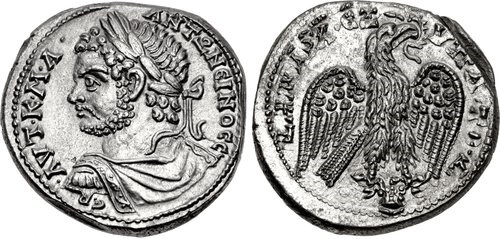
Portrait of Caracalla on tetradrachm of Carrhae
A different style of Caracalla portrait appears on this tetradrachm of Carrhae, in Mesopotamia.
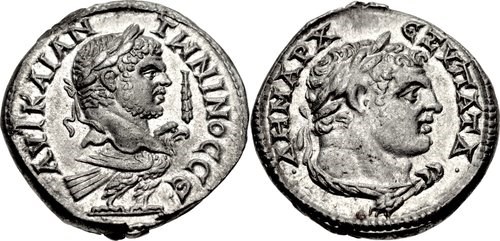
Tetradrachm struck at Tyre with portrait of the god Melkart
The city of Tyre, in Phoenicia, had been issuing coins long before the arrival of the Romans. This tetradrachm was struck at Tyre circa 215-217, during the last two years of Caracalla’s reign. The reverse bears the portrait of the god Melkart.

Roman tetradrachms with portrait of Caracalla
Roman tetradrachms often had unusual portraits, such as the one of Caracalla on an issue of Edessa in Mesopotamia.
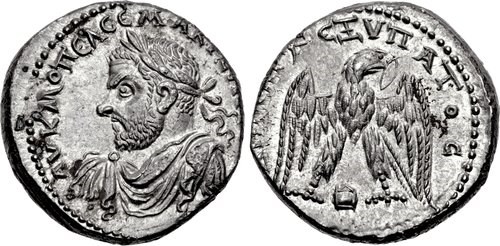
Edessa tetradrachm with portrait of Macrinus
Similarly odd is the portrait of Caracalla’s successor, Macrinus (217-218), on this tetradrachm of Edessa.
Some of Rome’s largest issues of imperial silver were struck at imperial mints in the provinces. Just like the cistophori shown earlier, these coins skirt the definitions of imperial and provincial coinage. Below are two examples that have particularly outstanding portraits.

Emperor Vespasian and his sons, Titus and Domitian
The Emperor Vespasian and his sons, Titus and Domitian (both then Caesars, though eventually they would reign as emperors), are portrayed on this denarius of the Ephesus mint.
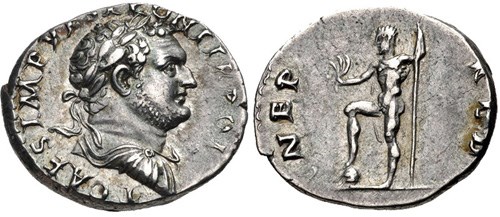
Imperial Mint Denarius of Vespasian
While Titus reigned as Caesar (69 to 79), Vespasian struck this denarius on his behalf at the imperial mint in Antioch, Syria.
Alexandria
Our final examples of portraits on provincial coins are from the mint of Alexandria in Egypt. Six pieces are illustrated below.
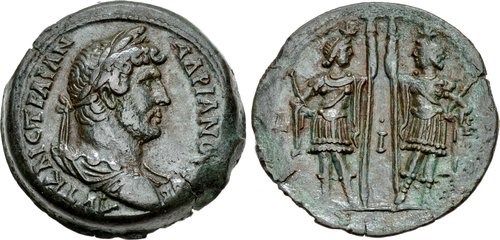
Copper drachm of Hadrian
This copper drachm of Hadrian was struck in 133/4 CE. It bears an attractive portrait and its reverse depicts the standing figures of the Dioscuri.

Billon tetradrachm of Hadrian and his wife Sabina
Also from Alexandria is this billon tetradrachm of Hadrian and his wife Sabina, struck in 132/3. Both portraits are in high relief and are of fine style.
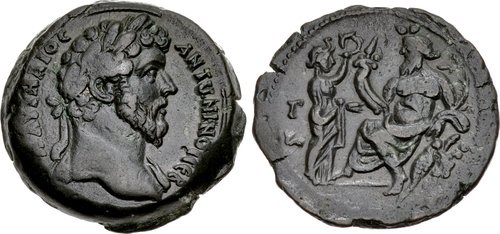
Emperor Marcus Aurelius on Copper Drachm
A stately portrait of the emperor Marcus Aurelius (161-180) appears on this copper drachm of 162/3. The reverse shows the personification of Alexandria crowning the river-god Nilus, who reclines on a crocodile.
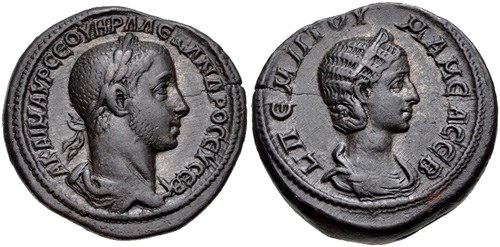
Young Emperor Severus Alexander and his mother, Julia Mamaea
The young emperor Severus Alexander is portrayed along with his mother, Julia Mamaea, on this billon tetradrachm of 225/6. The style of the dies are distinct enough that it is generally believed that these dies were engraved at the Rome mint.

Billon tetradrachm of Claudius II Gothicus
As the third century wound down, portraits on Roman coins became increasingly stylized, as exemplified by this billon tetradrachm of Claudius II Gothicus (268-270). It bears on its reverse a portrait of the Greco-Egyptian god Hermanubis.

Billon tetradrachm of Harpocrates of Pelusium
Among the last provincial coins to be produced is this billon tetradrachm of Diocletian (284-305), struck at Alexandria in 291/2. It shows on its reverse the standing figure of Harpocrates of Pelusium. By this time, the imperial portrait is merely a caricature.
* * *
Interested in reading more articles on Ancient coins? Click here.
NGC-Certified Ancient Roman Bronze Coins Currently Available on eBay
[wpebayads]





